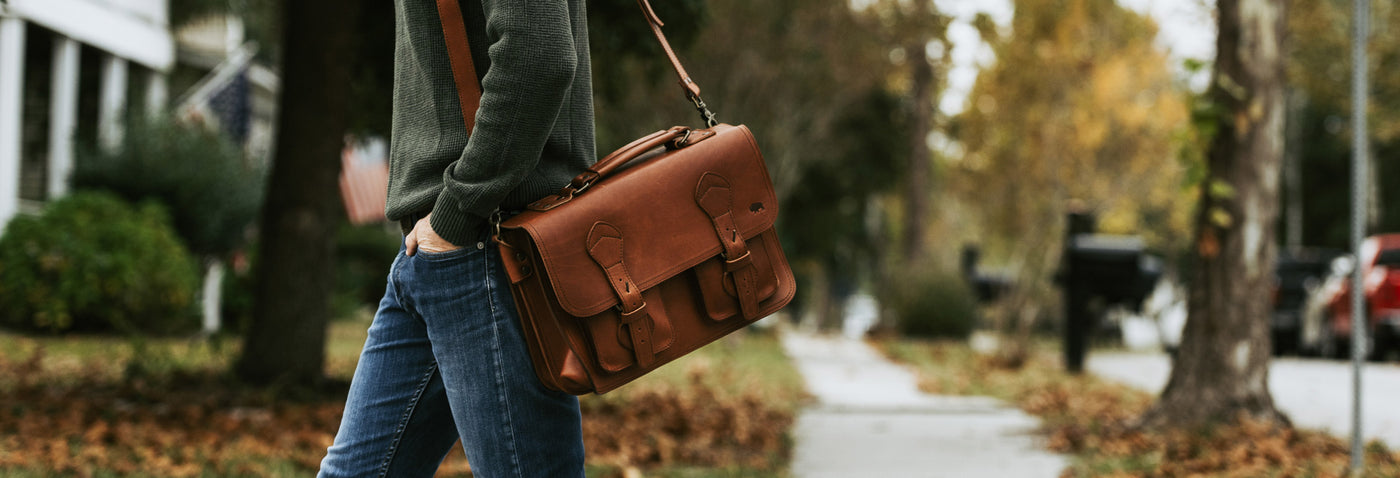Your Cart is Empty
You are $99.00 away from free shipping!
Your Cart is Empty
You are $99.00 away from free shipping!

Revised 10/20/20
Learning how to dye leather—and do it well—involves quite a bit of trial and error. But with a little practice and a lot of patience, it can definitely be mastered. Follow these 5 steps, and you’ll be well on your way.
- First things first: choose a ventilated work area.
- Rubber gloves: wear them.
- Cover/line your workspace to protect from dye stains.
- Soft cotton rags or t-shirt scraps are perfect for dye application.
- Cotton swabs work great for dyeing edges and corners.
- Leather dye (there are many options depending on what you’re dyeing: research and choose!)
- Oil (not conditioner; olive oil or jojoba oil work best)
- Vegetable tanned leather

- Use a clean cloth to briskly wipe down the leather and clean off any lingering dust and/or body oils.
- Use tape to cover any hardware you don’t want to dye.
- Hydrate the leather with a light coat of olive oil; hydrated leather will better receive the dye. Apply a thin layer in a circular motion with a clean cloth. (Don’t forget the edges.) Be sure you’re using olive oil or jojoba oil -- not a leather conditioner -- for this step. A leather conditioner will include waxes or glosses that will inhibit the dye from penetrating the leather.
- Dilute (or “cut”) the dye so you have room to use multiple coats to achieve your desired color. Full strength dye may result in your desired color on the first pass. This is not a good thing, as it leaves no chance to even out any blotchy areas. (Multiple coats = more even finish.)
- Dilute your dye with the base of the type of dye you’re using—if water-based, dilute with water; alcohol-based, dilute with alcohol; oil-based, dilute with oil. Or, look for a “dye reducer” that may be sold alongside your dye of choice.
- Using a soft cotton rag, gently apply your first coat of dye using a circular motion. Remember: applying several thin coats will more likely result in an even color (as opposed to an uneven slathering).
- Allow the first coat to dry.
- For additional coats, continue applying using the small circular motion and drying between coats. The aim is to cover the grain from every direction, leaving no un-dyed area.
- When you’ve reached the desired color, let the dye dry completely (24 hours should work). Do not touch it at this point or you’ll smudge the dye.
- After the final coat of dye has completely dried, it’s time to apply a wax based conditioner. Leather conditioner will re-hydrate the leather from any drying caused by the dyeing process or the dye itself, and it will help seal the color.
- Apply the conditioner with a soft cotton rag in a circular motion.
- Allow the conditioner to dry, and then lightly buff with a clean rag.
As we mentioned above, please do not underestimate the amount of trial and error involved in learning how to dye leather. It can definitely be a fun project. It can also ruin your favorite leather belt or bag if you decide to dive in and do something crazy.
Whether you’re dreaming of a soft honey brown leather purse or a rugged dark brown wallet, do your research, practice your craft, and if all else fails, chuck the dye and invest in a new item that’s already just how you want it.
Be sure to read our "How to Care for Leather" article to stay on top of caring for your newly dyed leather!
Orders shipped to Canada may be subject to import duties, tariffs, and taxes charged by Canadian customs. These fees are not included in our prices or shipping costs. You will be responsible for any additional charges upon delivery. Please review local customs regulations before placing your order.

